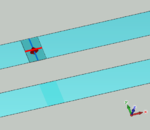Follow along with the video below to see how to install our site as a web app on your home screen.
Note: This feature may not be available in some browsers.



You can use discrete edge ports as is shown in the following image:
View attachment 114739
It represents a delta gap excitation. First inside the slot define your delta-gap with dy=Ws and dx=0.7*Ws, where Ws is the width of your slot (gap). You can alter the 0.7 of course. Secondly define your discrete edge port in this delta-gap. Thirdly you can use symmetry planes, a magnetic wall in the yz-plane and depending on your excitation mode a magnetic wall in the xz-plane (differential mode) of electric wall in the xz-plane (common mode). Of course you can also just define an additional edge port if you can not work with symmetry planes.
Sven

hello
how can I do the excitation for conductor backed CPW???
which kind of port???

Hi there,
I would recommend you to put required boundary conditions. As, parallel plate mode and slot mode are easily excited otherwise.
I go for wave guide port size as explained by CST , you can see in CST help section by pressing F1.
However, keeping electric wall in sidewall helps to suppress the parallel plate mode. And, just case to avoid slot (odd) mode, u can place magnetic wall from the center line in feed direction.
Hope this helps!